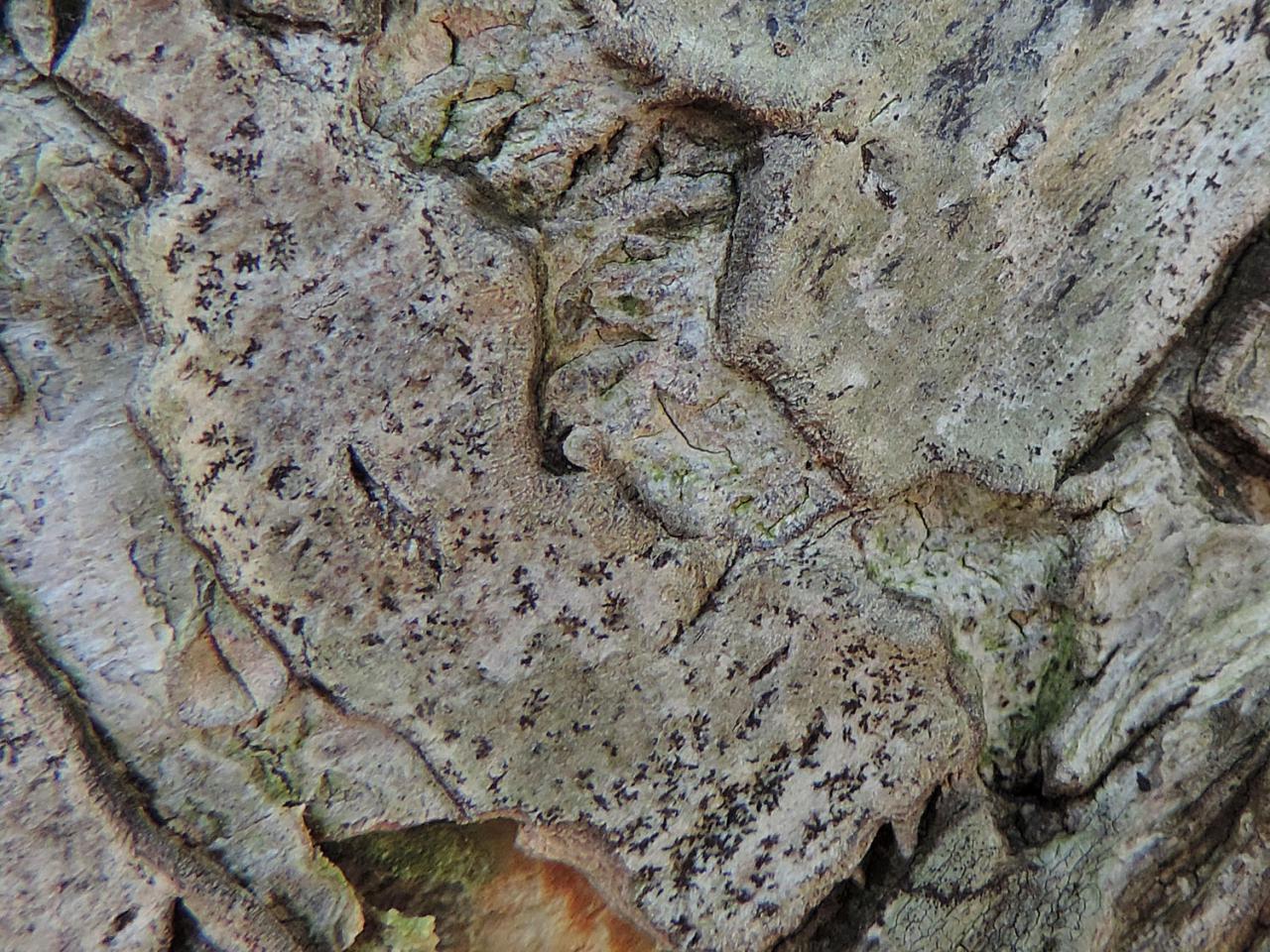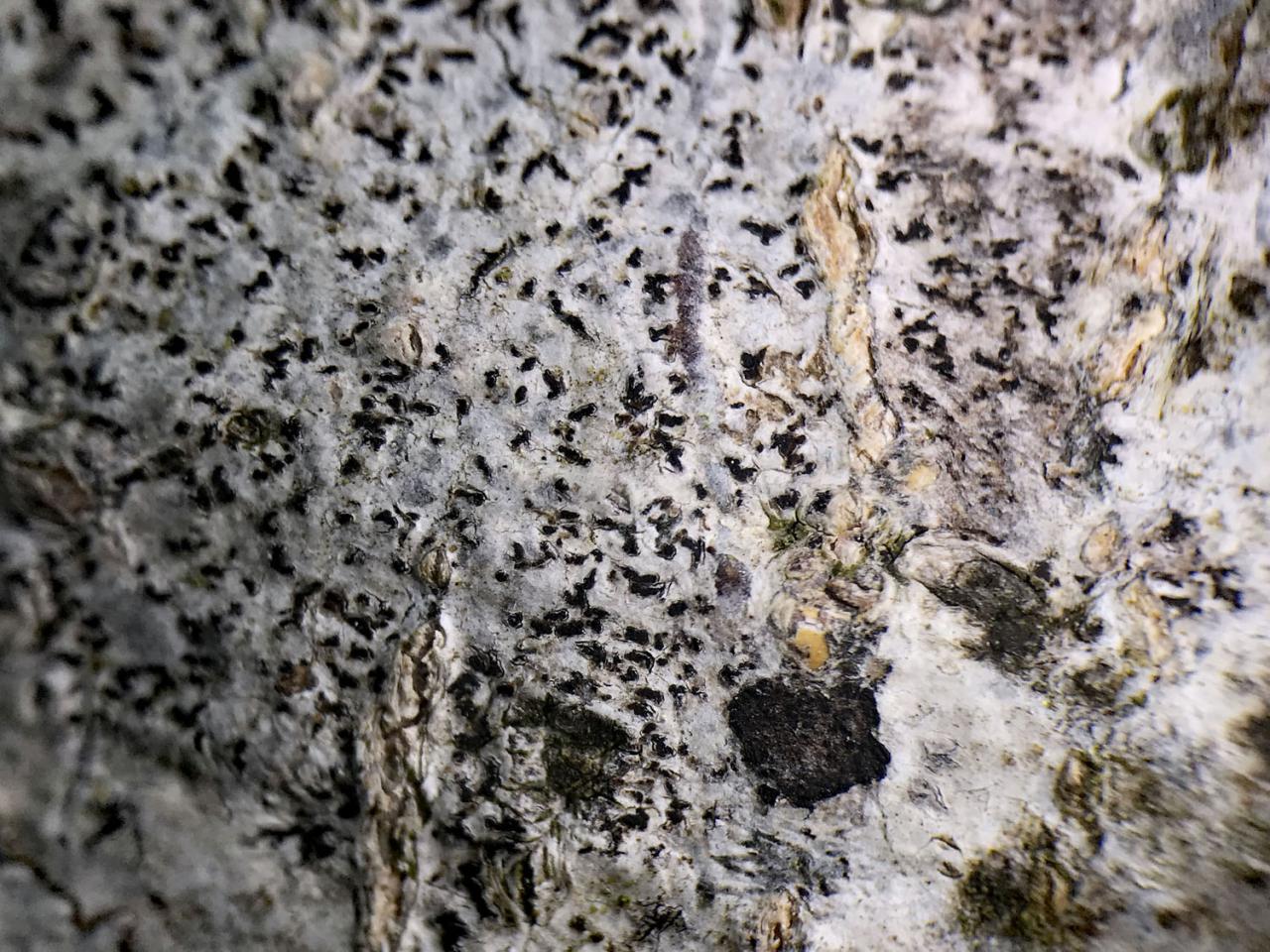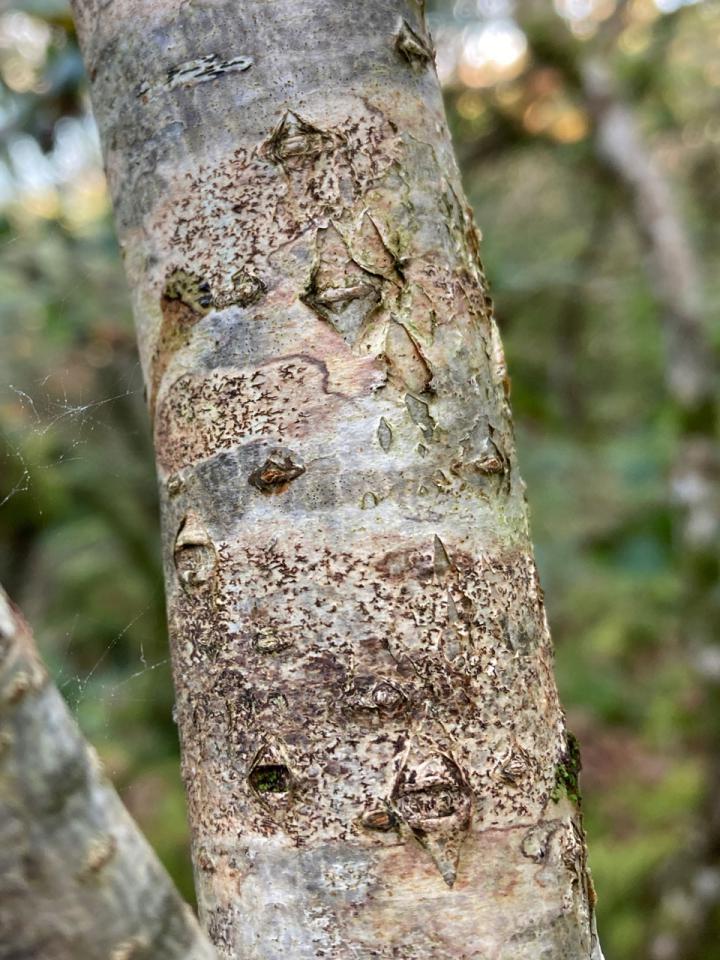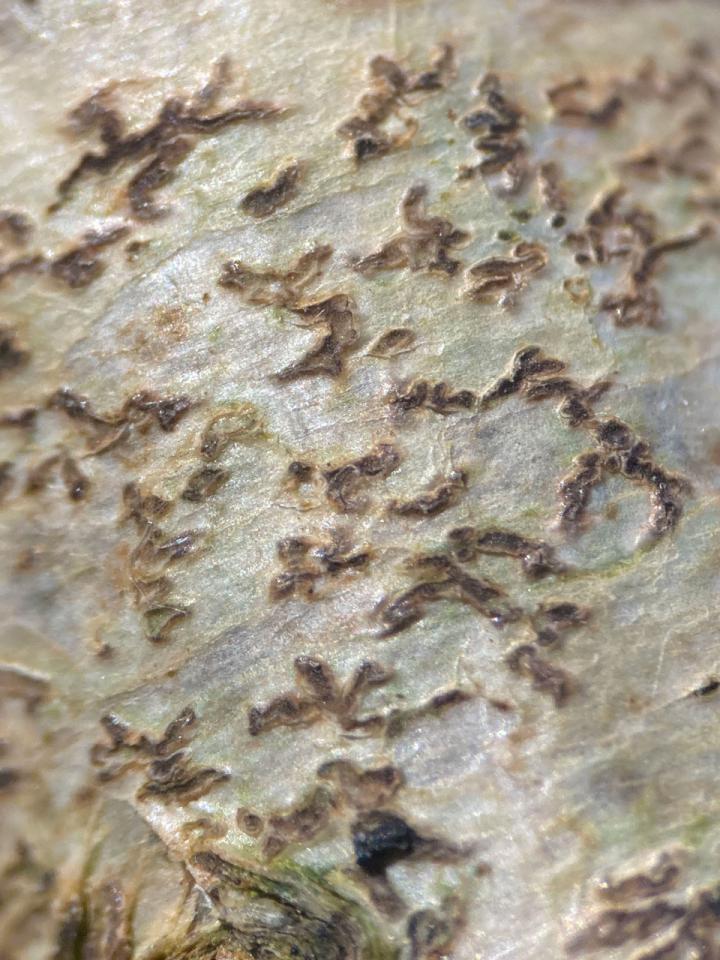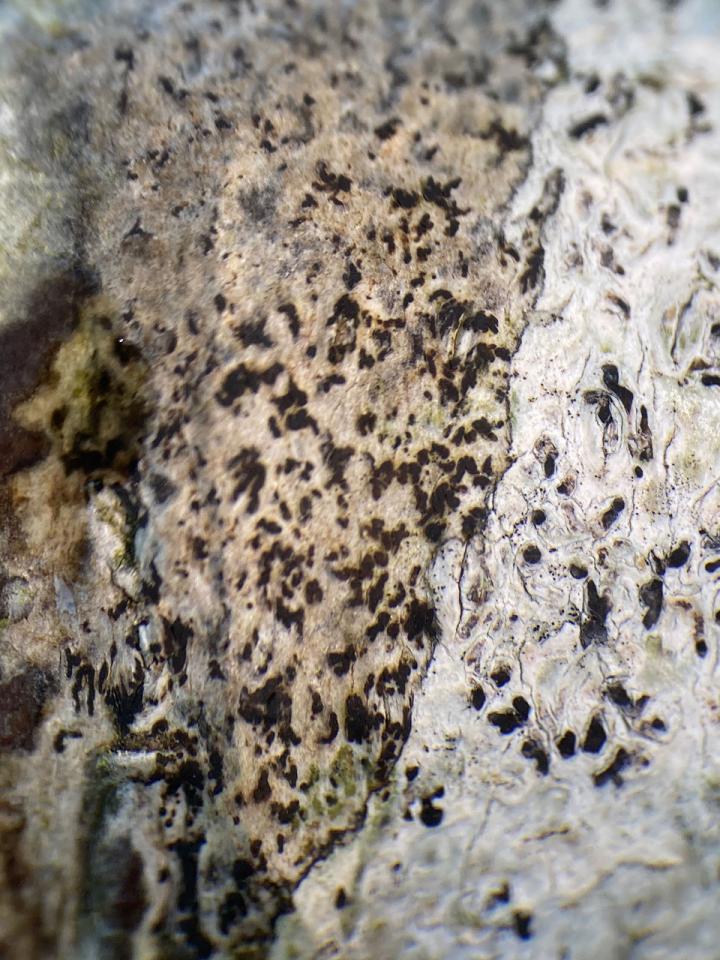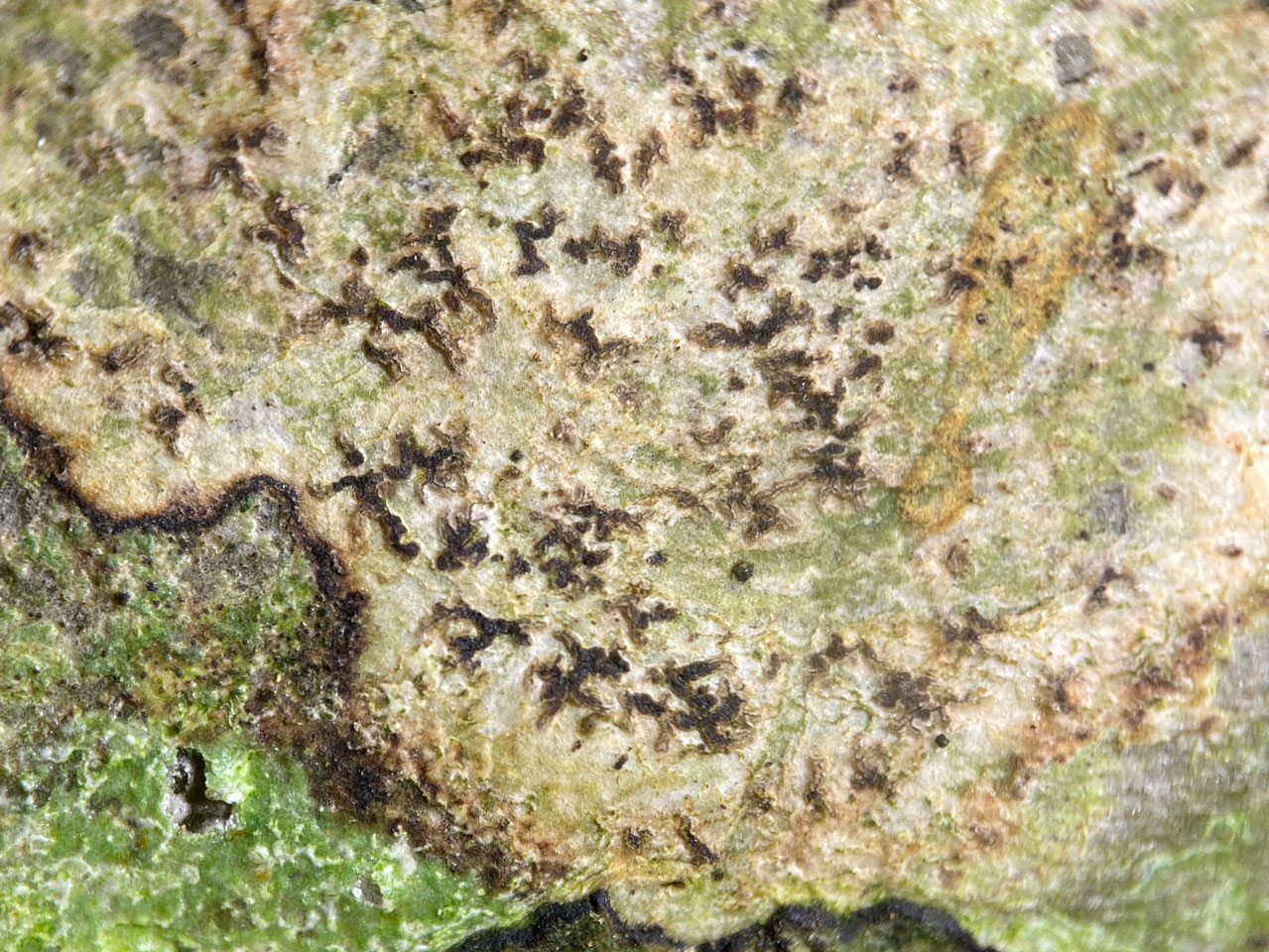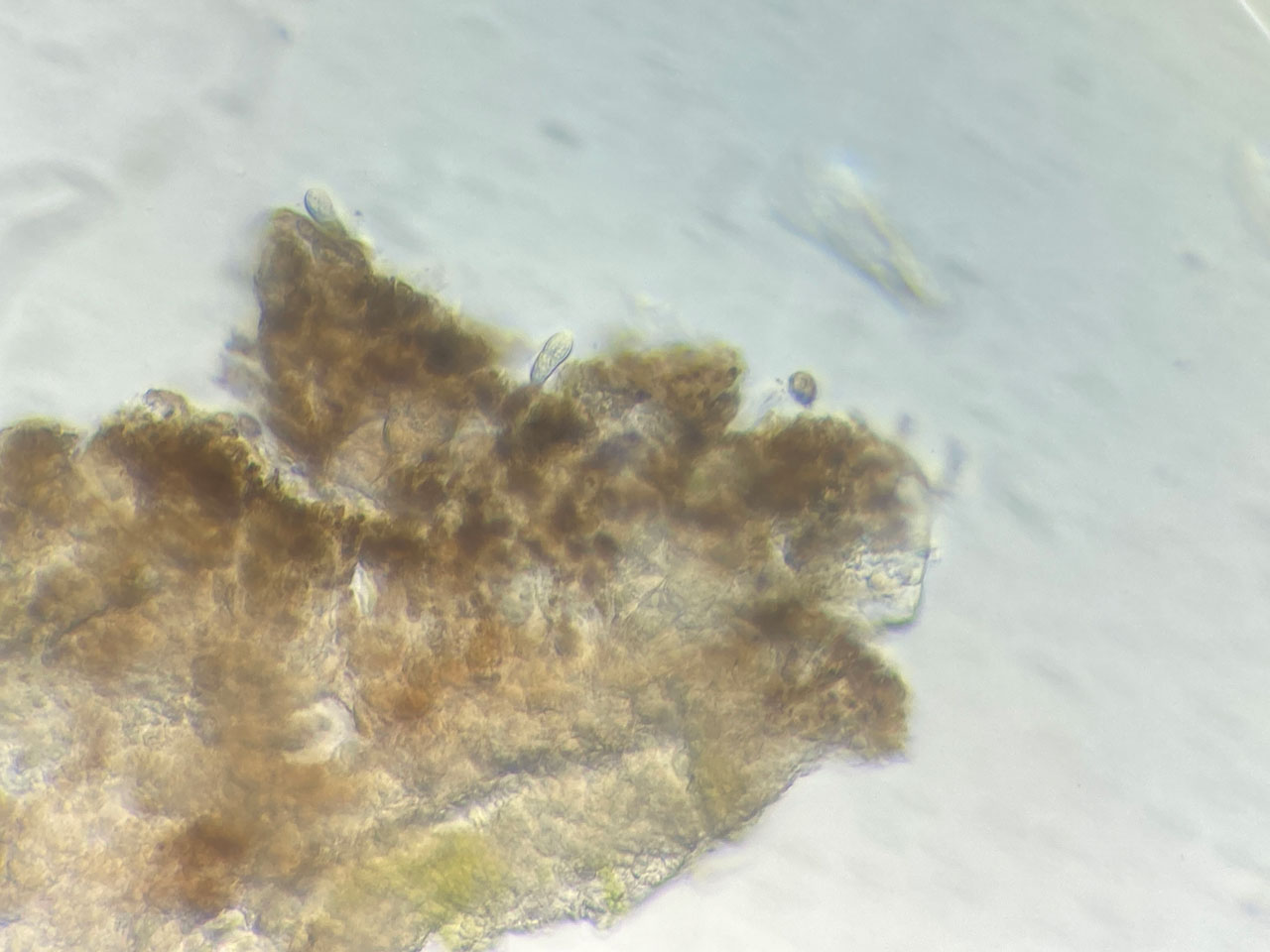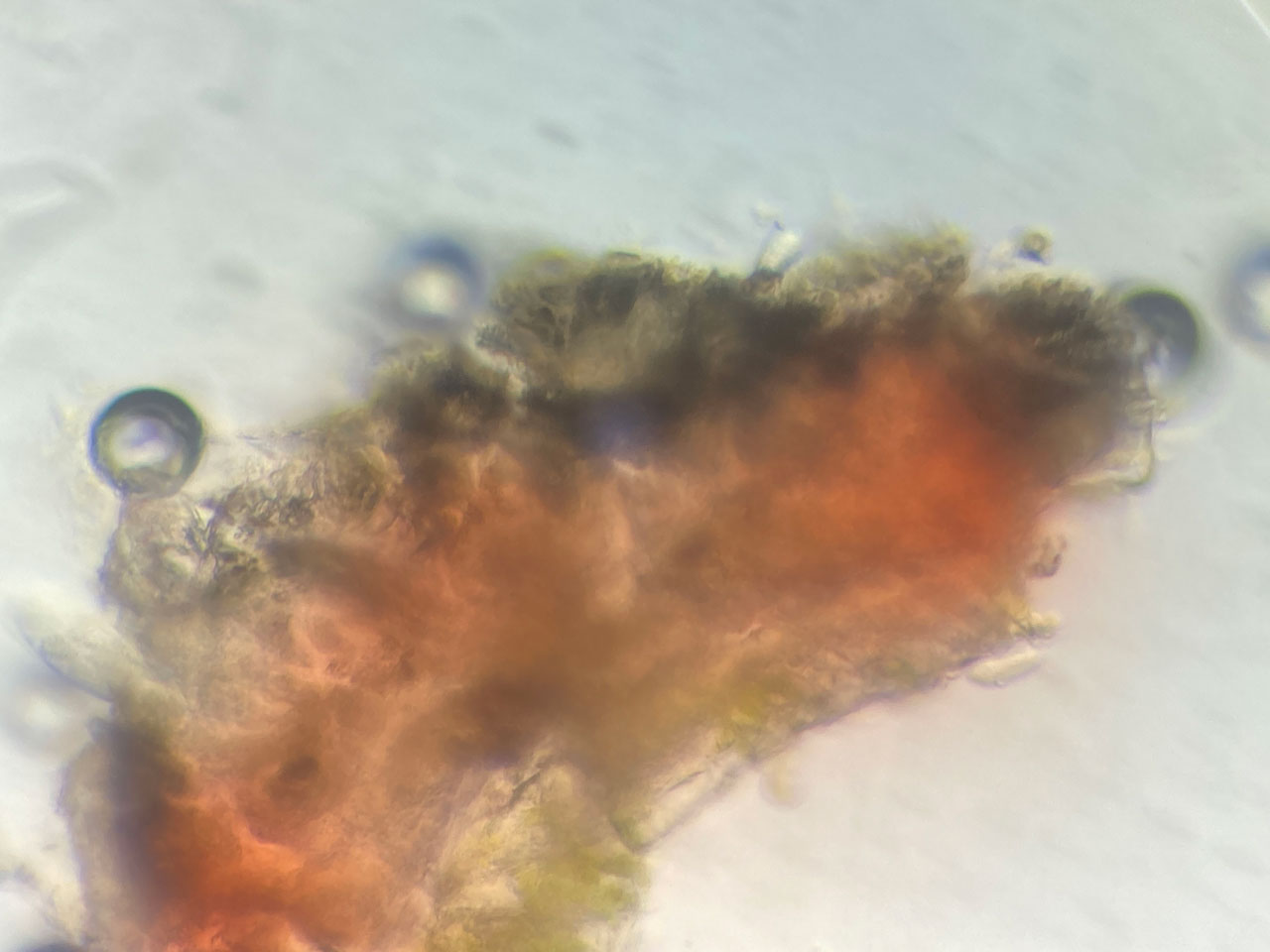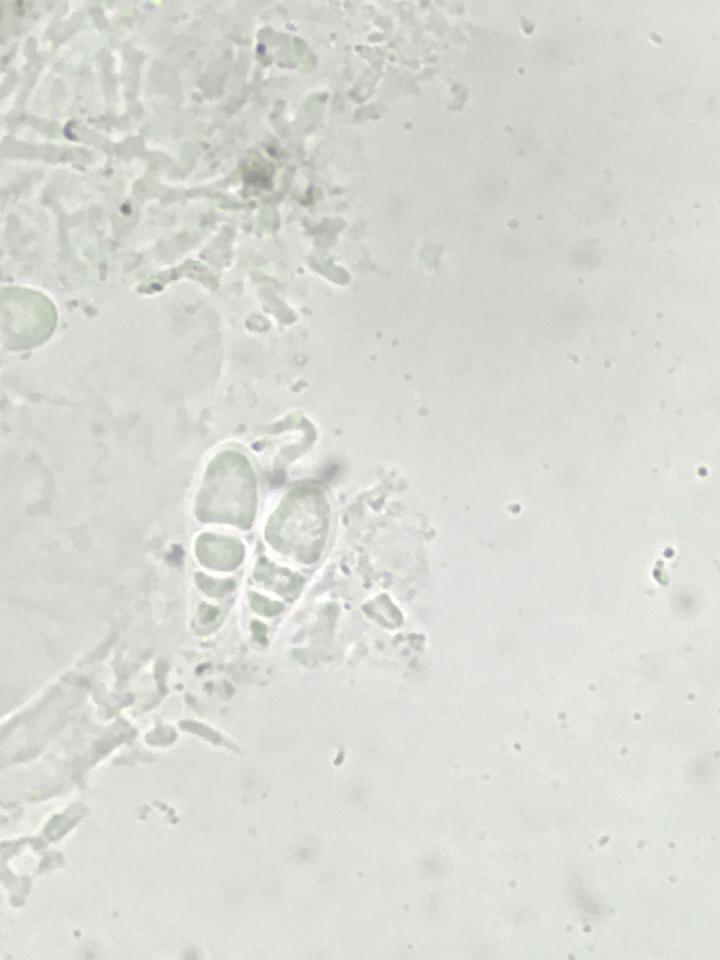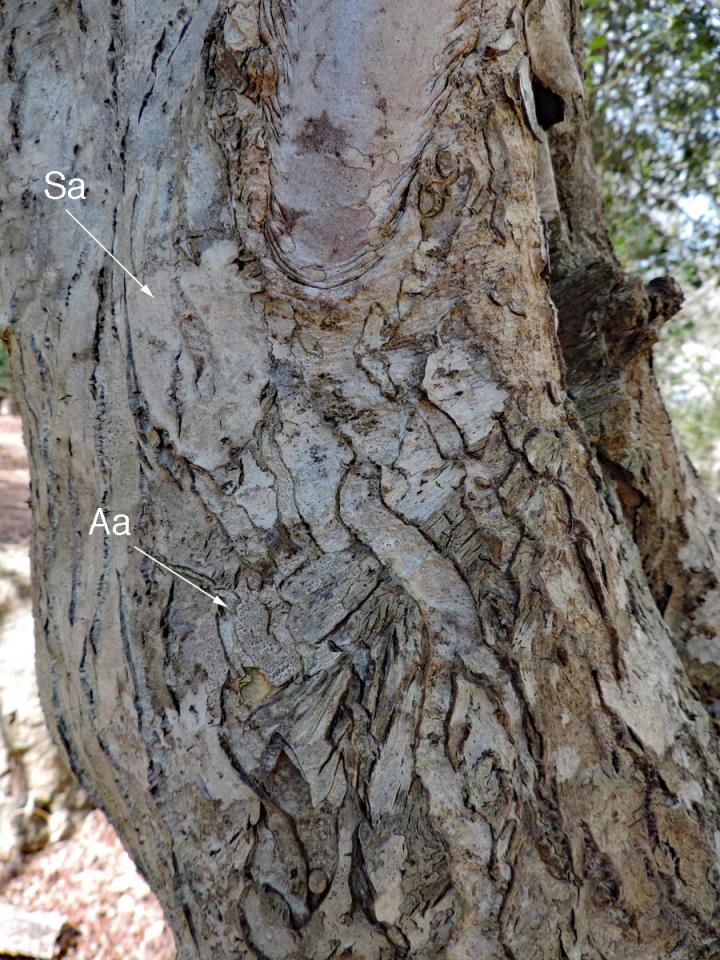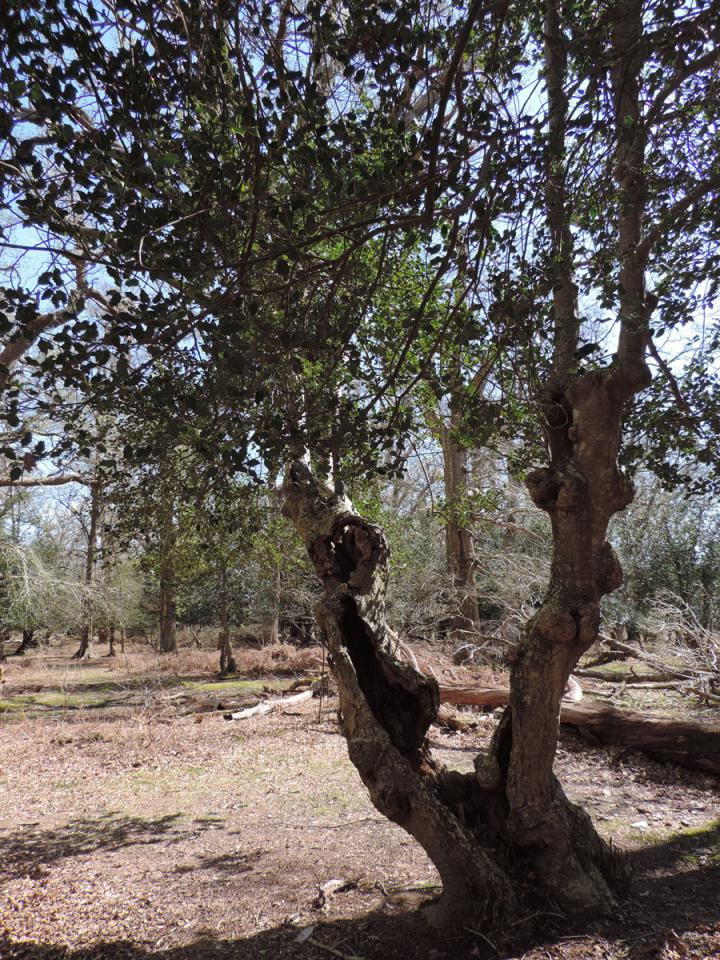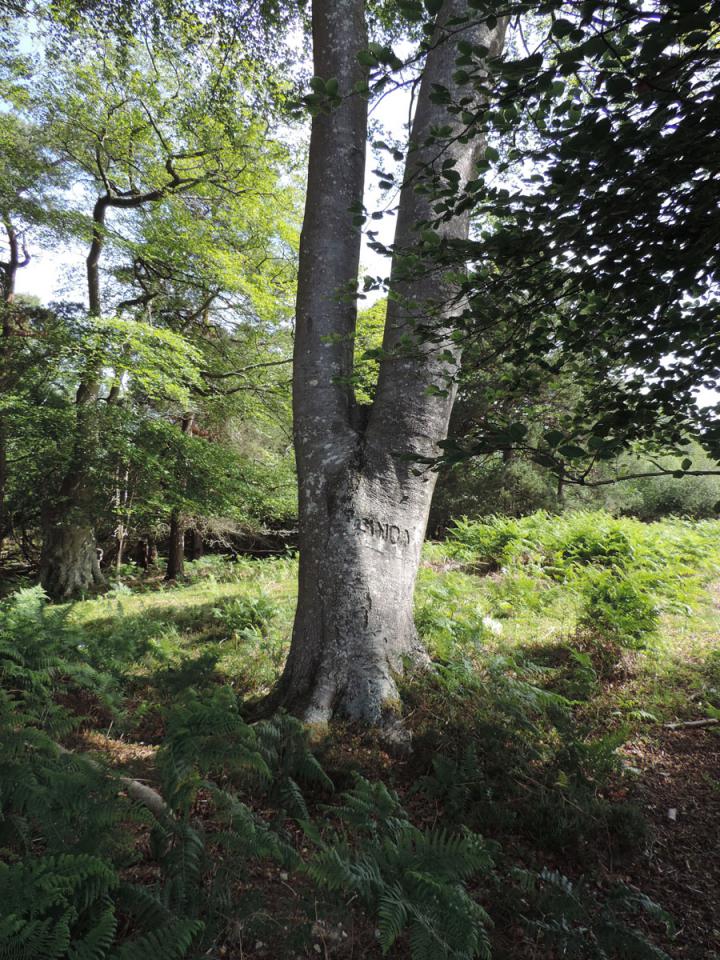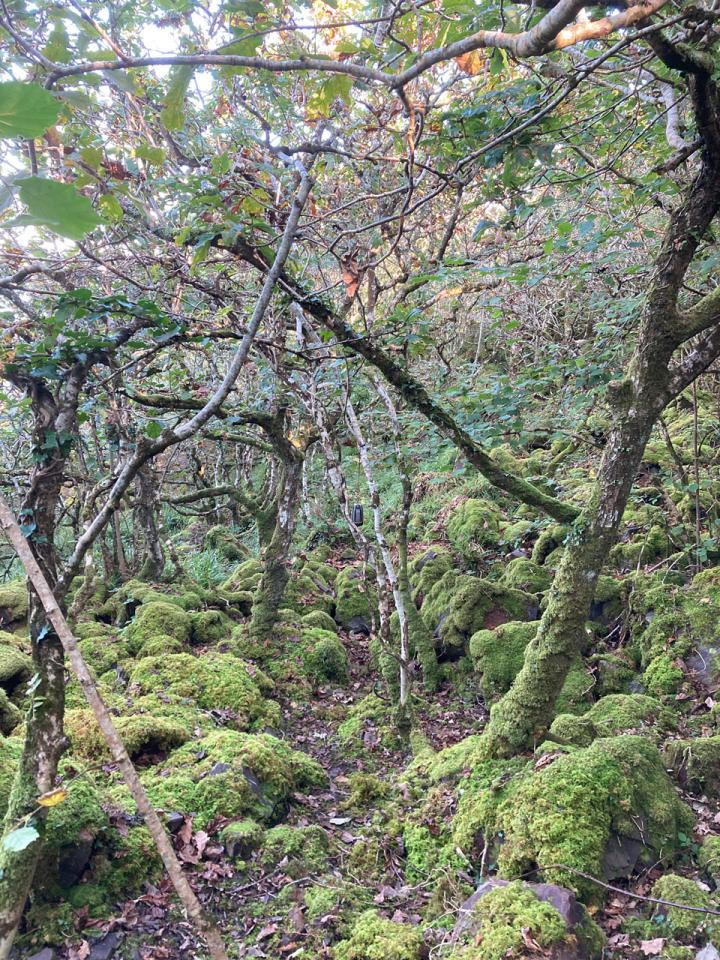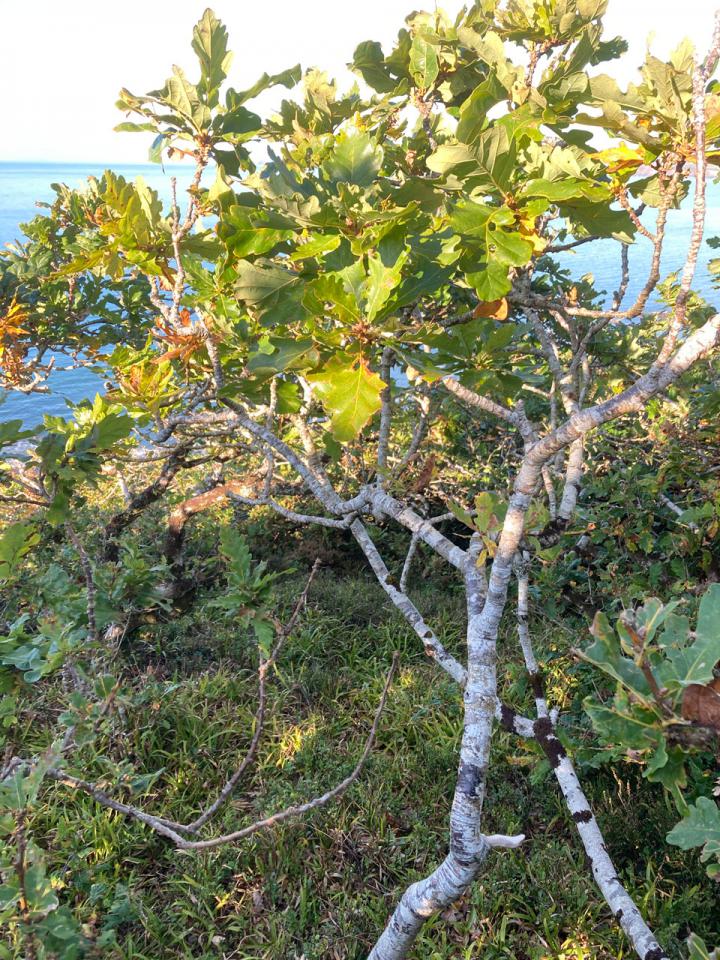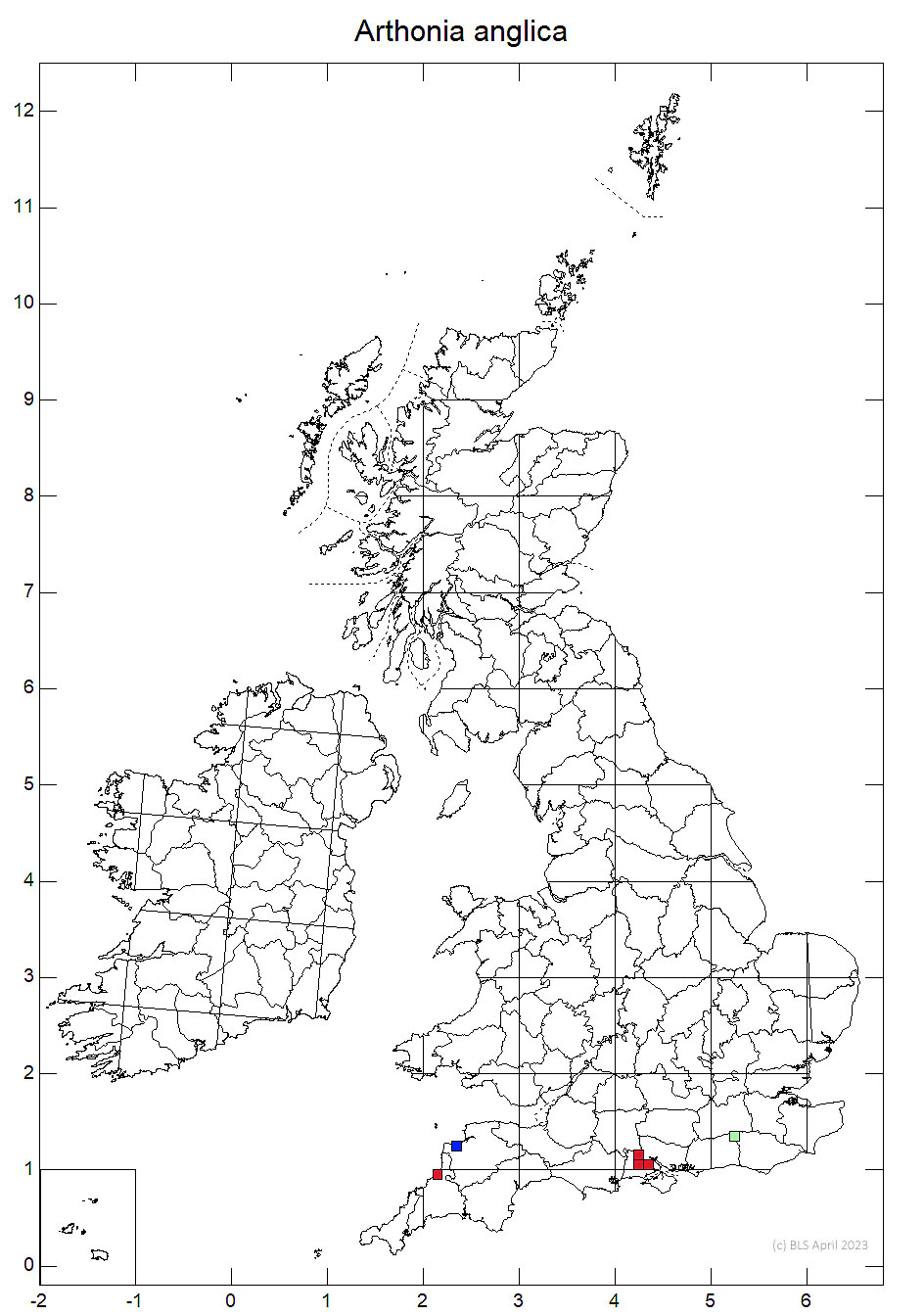Arthonia anglica
A rare south oceanic Reichlingia type Arthonia found on smooth bark in humid oceanic woods in the south and south west of England.
Thallus immersed, delimited by a dark brown line, grey-white to pale fawn. Apothecia mostly irregularly stellate, rays 80–160 μm broad, black to dark red- brown, not pruinose; epithecium pale to dark red-brown, K+ olive; hymenium and hypothecium colourless. Asci 50–55 × 21–24 μm. Ascospores (16–) 17–24 × 6–7 (–8) μm, obovoid to cylindric-obovoid, (2–) 3- or 4- septate, the apical cells enlarged; old ascospores brown and warted. Pycnidia absent. Thallus C–, K–, KC–, Pd–, UV– (apothecial sections C+ red, gyrophoric acid). (Adapted from the description in Cannon et al (2020)).
The thallus colour is quite variable being white on well lit bark, especially on Beech and Holly, typically with black apothecia, but pale fawn with more reddish apothecia on shaded Holly and Rowan and well lit Oak branches.
Ertz & Tehler (2011) and Van den Broeck et al. (2018) found that African material identified as this species clustered away from the main Arthonia clade, and close to Reichlingia, however, European material has not yet been sequenced.
Arthonia anglica can, with experience, if not exactly identified in the field, then have its identity strongly suspected. Once voucher material is collected it can be easily confirmed using microscopic characters. Microscopically the combination of quite large 3 – 4 septate spores with an enlarge end cell and the C+ red apothecia sections are highly diagnostic. The problem is spotting likely material to check. It has been confirmed that the C+ red apothecia reaction can be often be detected in the field as red colouring diffusing out of apothecia tested with C, but the amount of gyrophoric acid is variable and not all thalli produce reactions strong enough to be seen in the field. What seems to be an effective field technique is to place a small amount of K on an apothecia, soak this up in a tissue and then apply C under close observation: for A. anglica a brief flash of red colour can be seen on the tissue paper.
The differences with three most similar species that occur in similar habitats are described below:
Synarthonia astroidestera (Arthonia astroidestera) is a generally very similar Reichlingia clade type Arthonia, also with a pale thallus and black irregularly stellate apothecia and similar spores. The main field difference are the coverings of white pruina on fresh apothecia, which are fluorescent bright orange. This pruina can be rubbed off in older specimens but traces always remain. Modern powerful UV lamps make the separation of likely Arthonia anglica from old worn S. astroidestera much easier, even when only limited coverings pruina remain on the latter. Microscopically Synarthonia astroidestera is similar with the spores also having an enlarge end cell but the apothecia are C– in cross section.
Coniocarpon cuspidans (Arthonia elegans) can look very similar to the morph of A. anglica with a pale fawn thallus with more reddish apothecia. In Coniocarpon cuspidans the apothecia are purple-brown and are K+ red, the latter usually visible in the field as colour diffusing out of the apothecia. Arthonia anglica apothecia are dark red-brown and K–.
Arthonia radiata is a distantly related species and a true Arthonia, mainly found in pioneer habitat on twigs, but older colonies on Beech trunks can look surprisingly similar. Well developed material on old Beech trunks has a similar white thallus with black apothecia. The apothecia, however, are rounded to substellate and are never quite as strongly stellate as Arthonia anglica but can come very close. Internally they are very different with the Arthonia radiata spores lacking an enlarged end cell and having C– apothecia.
The general habitat requirements and limitations of Arthonia anglica can be summarised as moderately acid to sub-neutral habitats on smooth bark in micro-habitats that have good flows of water when wet but then rapidly dry, on smooth bark on old or slow growing trees and bushes in little disturbed woods. Known sites where the lichen is thriving are well-lit but with high atmospheric humidity and the lichen avoids full sun and nitrogen enriched environments. Observations suggest the species is less tolerant of shade than Synarthonia astroidestera.
In the two known extant populations, The New Forest and Dizzard Point, Arthonia anglica thrives on well lit but sheltered trees and bushes while in shady conditions the thalli are generally in poor condition. Both are sites with significant grazing pressures, from commoners stock and fallow deer in the former and red deer in the latter.
Sanderson (2021) surveyed the north Devon sites for Arthonia anglica, from Clovelly to Peppercombe in 2020, and found that, in contrast to the New Forest and Dizzard Point, these woods were deeply shaded and the survey failed to refind any Arthonia anglica. Earlier accounts indicated that these now ungrazed woods had been much more open until quite recently.
Arthonia anglica has recently been recorded from Holly and Beech in the New Forest in Beech – Holly Oak pasture woodlands and on Holly, Rowan, Oak branches and Sycamore in dwarf coastal Oak wood in The Dizzard. It had also been recorded from Ash in the south west in the past. On Beech it grows in the Mature Mesic Bark Assemblage (Graphidion, Pertusarietum amarae), with Pertusaria species including Pertusaria pustulata (VU). On the other tree species it grows in the Well Lit Smooth Bark Assemblage (Graphidion, Graphidetum scriptae) with associated species including Arthonia ilicinella (NT), Arthonia ilicina (Nb), Arthopyrenia nitescens (Nb), Enterographa crassa, Enterographa hutchinsiae, Mycoporum lacteum (NT), Pertusaria pustulata (VU) (parasitised by Sphinctrina tubiformis (Nb)), Phaeographis dendritica, Snippocia nivea (Schismatomma niveum) (Nb), Synarthonia astroidestera (Arthonia astroidestera) (NT) and Thelotrema lepadinum.

Material matching Arthonia anglica appears to have pan-tropical to warm temperate distribution having been recorded in south west Europe, Macaronesia, eastern USA and Rwanda, Africa. In Macaronesia Arthonia anglica has been recorded from Madeira and La Gomera, Canary Islands, where it is epiphytic in laurisilva vegetation. Found new to continental Europe in 2019 in a single location in Finistère, France where it is extremely rare on smooth bark of Holly and Beech
In England Arthonia anglica has been recorded in two distinct regions: coastal woods on the north coasts of Cornwall and Devon and in ancient deer forests in Hampshire and West Sussex. It has been recorded from two meta-sites in each region. In Cornwall it was record once from Millook in 1989, while the Devon Clovelly to Peppercombe meta-site has four records from 1974 to 1998 all from different woods. These were all single collections. There have been no post 2000 records from the Clovelly to Peppercombe meta-site in spite of an intensive survey in 2020. It was, however, discovered in 2021 at Dizzard Point, nearby to Millook. In the latter it was recorded on 10 trees (Lamacraft & Sanderson, 2022).
In the south east, the species was first collected from St Leonards Forest in 1806 but has not been seen since and most of the habitat here was destroyed by enclosure shortly afterwards. In the New Forest the species has six records, one from 1868 and five from 2016 to 2022. The modern records are from four separate woods.
Britain: listed as Endangered in the British red list, Nationally Rare and an International responsibility species.
England: listed in Section 41 of the Natural Environment & Rural Communities (NERC) Act 2006.
Increasing Shade: the major problem with the Arthonia anglica on the north coast of Devon appears to be increasing shade (Sanderson, 2021). Very few suitable trees were located in anything like as well lit conditions as those found in the New Forest woods or Dizzard Point. Areas with previous records of Arthonia anglica were especially dark. This seems to be part of a historic trend from more open grazed woodlands on the coastal slopes to very dense, dark and difficult to penetrate non-intervention woodland. The last grazing by cattle in the coastal slope woodlands was reported as being in the 1960s (Coppins & Coppins, 1999), not long before several of the finds of Arthonia anglica in this area.
Extant trees with vigorous Arthonia anglica thalli in New Forest woods and Dizzard Point are all in well lit situations, while thalli at both sites in deeper shade were in poor condition.
Unsuitable Long Term Management of Wider Habitat: given the apparent low density of occupation that appears typical of this species in Europe, thriving Arthonia anglica populations are likely to need large areas of well managed old growth woodland. This needs to include numerous suitable old or slow growing trees or bushes, with frequent glades and broken edge habitat in sheltered and humid locations. The loss of this sort of landscape in West Sussex to the enclosure of St. Leonards Forest, resulted in the loss of the species, probably by the early 19th century. Later 20th century changes removing extensive grazing from marginal habitat in north Devon and Cornwall is leading to the loss of this habitat too at a landscape level.
Cannon, P., Ertz, D., Frisch, A., Aptroot, A., Chambers, S., Coppins, B. J., Sanderson, N. A., Simkin, J. & Wolseley, P. (2020) Revisions of British and Irish Lichens Volume 1 August 2020 Arthoniales: Arthoniaceae. BLS https://www.britishlichensociety.org.uk/content/lgbi3
Coppins, B. J. (1989) Notes on the Arthoniaceaea in the British Isles. Lichenologist 21: 195-216.
Coppins A. M. & Coppins, B. J. (1999) Peppercombe and Portledge North Devon (VC 4), Lichen Survey III, June 1999. A report to the National Trust.
Ertz, D. & Tehler, A. (2011). The phylogeny of Arthoniales (Pezizomycotina) inferred from nucLSU and RPB2 sequences. Fungal Diversity 49: 47–71.
Lamacraft, D. M. & Sanderson, N.A. (2022) Survey of the Dizzard for Pseudocyphellaria citrina. A Dave Lamacraft, Ecological Services Report to Natural England
Sanderson, N. A. (2021) Porina effilata and Arthonia anglica Clovelly to Peppercombe, North Devon and Arthonia anglica in the New Forest, Hampshire. A report by Botanical Survey & Assessment to Natural England.
Van den Broeck, D., Frisch, A., Razafindrahaja, T., van der Vijver, B. & Ertz, D. (2018). Phylogenetic position of Synarthonia (lichenized Ascomycota, Arthoniaceae), with the description of six new species. Plant Ecology and Evolution 151: 327–351.
Text by Neil A Sanderson, based on Cannon et al (2020) & Sanderson (2021)
